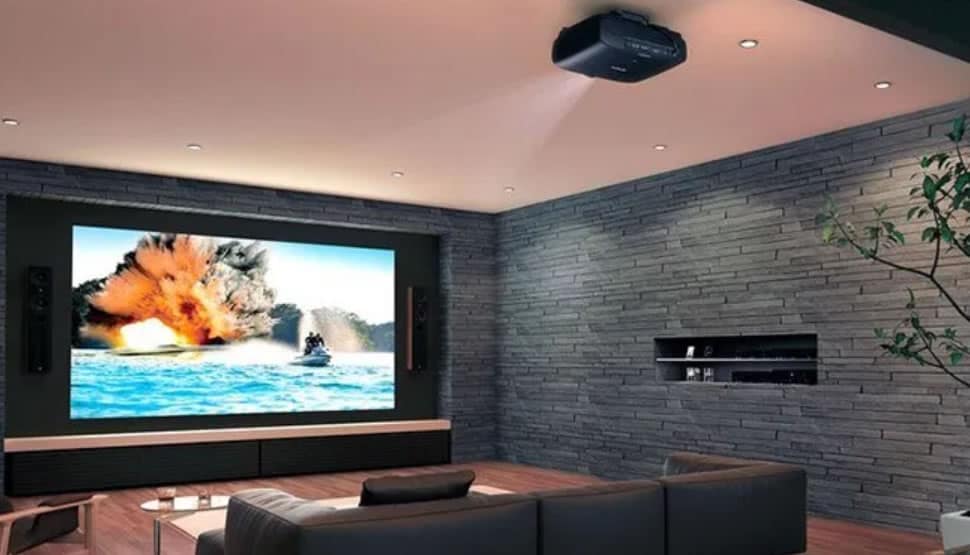
Many people are thinking about buying a projector. This article will give you information to help you make your purchase. You should know about things like the size of the screen, brightness, and price.
First, make a plan for what you want to use your projector. For example, if you’re going to show a movie in your living room, or if you want a projector that is used in offices. You can then pick from projectors that are made specifically for these purposes.
To help you with your buying guide for buying a projector, we give you the key factors to consider when purchasing one.
The Essential part Of the projector
Resolution
A home theater projector should be at least HD 1920 x 1080 pixels. A 4K / UHD (Ultra High Definition) model is an option, but the quality is not that good.
Brightness
A brighter projector means that it will show good images even if there is little light in the room. A brightness of around 2000 lumens should be enough for use in a very dark room.
Distance
Projectors have either long or short focal lengths. The distance between the projector and the screen will depend on the type of projector. The ratio of this distance to the size of your screen can tell you how far to put your projector so that it will fit on it.
The projector’s throw distance will vary depending on the type of projector you are using. For example, home theater projectors can have a throw distance that ranges from 3-10 feet, and commercial projectors can have a throw distance that ranges from 10-25 feet.
Quality
More subjective, the appreciation of the projected image’s quality depends on many factors (high resolution, contrast ratio, colorimetric rendering, etc.).
Projector Buying Guide All Key Points
To find the right projector, you will need to decide what your needs are. Here is a list of the main choices.
Table Of Content
- The Essential part Of the projector
- Projector Buying Guide All Key Points
- Types of projectors
- Specific Projectors
- Technical Guidelines
- LAMP Technology
- Format & Resolution
- Projector Installation
- Placement and Projection Balance
- Image Corrections / Adjustments
- Connections
- Sound
- Screen
- Support
- Price
- Maintenance
- Conclusion:
- Statistics Of The Projector Buying Guide
- Frequency ask question
Types of projectors
There are many different types of projectors. The type can classify the projector it is used for or its features. It can use the projector for home cinema or presentations in an office, and you can find different sizes, resolutions, and lengths.
Home Theater / Office
The first thing you need to think about is the type of use you want for your projector. There are two types: those for professional service and those for home theater use. But it’s not clear where the line between them is, and many models will be ready to use with both benefits.

Home Theater
- Presentations, graphics, …
- 4: 3 or 16: 9 format
- Compact, bright, functional

Professional
- Movies, video games,
- 16: 9 aspect ratio, HD resolution
- Image quality, silent, 3D
Business projectors are practical and show the image well. Home theater projectors are more for the quality of the picture.
Specific Projectors
Depending on your requirements and your budget, you can find the following categories:
- Short throw projector. Ideal for people who have a small space or want to enjoy a really big image.
- Portable mini projector. The small models are easy to take with you. They are not for everyday use, but they can be helpful when you travel.
- Wi-Fi mini projector. The most basic offer a mirror mode (mirroring the smartphone screen), while the most advanced include an operating system for any one.
- 4K projector: With 4x higher resolution than Full HD devices, the projected image is incredibly sharp. But UHD / 4K projectors are still rare and expensive.
- Laser projector (4K or HD resolution). It is very bright but still expensive today. Laser projectors are getting more popular. There are not many models though.
The comparison will let you see all the models. You can filter them based on things like resolution, brightness, and brand.
Technical Guidelines
It is important to figure out the technical features of a projector before you order one.

There are many projectors available in the market. They all have advantages and disadvantages. There are three types of projectors:
- DLP Projectors:There are many types of technology. Benq, Optoma, and Acer are the most popular ones because they have good quality. The image is very clear (contrast, color, sharpness), but some people might notice rainbows.
- 3LCD (or tri-LCD): The per-square of Epson, the designer of this technology, free from the rainbow effect. Home cinema models with good picture quality are still relatively expensive.
- LCOS: This is the best type of home cinema. It has a better quality but it is more expensive.
Regarding the DLP / LCD projector’s choice, today both are good. If you have a budget, then just pick one. It doesn’t matter which one.
LAMP Technology
There are several different types of lamps. Some are projectors and others are not.
- UHP (mercury lamp): This is the lamp model used in most projectors, especially home cinema. They are bright, and they last between 3000 to 5000 hours.
- LED: The lamps are more light and silent. They are most often used in offices. The lamps have a long life, so they last longer than mercury lamps.
- LASER: Laser projectors are technology for the future. They are very bright and the lamp life is 5 to 10 times longer than conventional lamps.
Format & Resolution
You can choose either a 16: 9 format or a 4: 3 one. I recommend that you select the full HD 1920 x 1080 definition if you want to enjoy movies and video games on your big screen, but if your budget is limited, you can go with 1280×720.
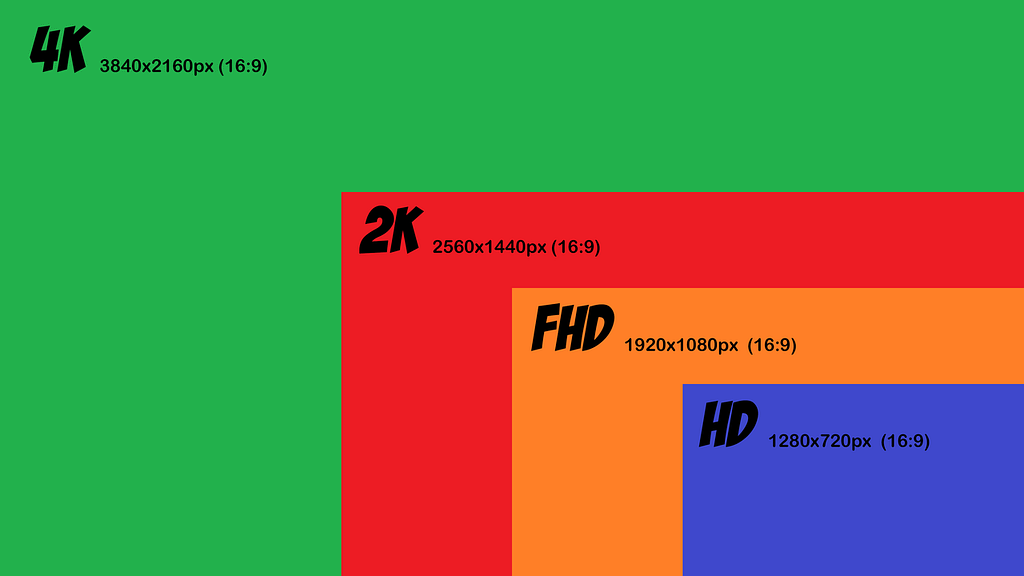
The Ultra HD (UHD) technology is still new, so it’s only been developed a little bit. But many people do not have 4K projectors to watch it. And there are not very many movies or TV shows on UHD. So the HD format remains the most common one that people use to watch movies and TV shows.
Learn more about formats and resolutions
Brightness
The brightness of a projector is how much light it puts out. It’s how bright it will look in the room. If you have lights on, you might need to turn up the projector so people can see what they are looking at.
When you watch a movie at home, the brightest mode of 2000 lumens is enough for light. If it’s not bright enough, turn up the brightness. The brighter mode is 1800 lumens and has a wider zoom than projector types with built-in lenses.
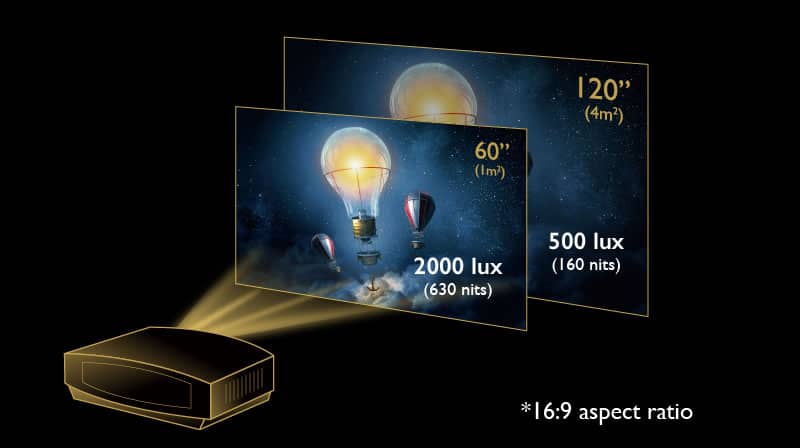
Office projectors are often used during the day. As a result, they need more brightness than home cinema models or big-screen gaming.
The brighter the projector, the better the picture will be. It’s best to have a dark room where you are showing your photographs.
CONTRAST
The contrast in an image is one of the essential qualities to a viewer. But it is hard to measure how much contrast there is because it depends on the light. Manufacturers do not always know what they are talking about.

Unfortunately, different camera manufacturers use other measurements. They also have additional features like a dynamic iris. This makes it hard to compare models based on the data given.
But, user reviews or product testing will provide you with more information about image rendering (contrast and color).
TIPS: Choose a contrast of at least 5000: 1
HDR
The HDR is a technology that makes it possible to project an image with high and low lights. It can also show more details in dark and light areas. There are different standards, the best known of which are Dolby Vision, HDR10, and HDR10+.
NB: To benefit from it, you need a projector that is compatible and also the content in HDR format.
Projector Installation
Choosing a projector is essential. You need to think about how you will connect it and where you will put it. For example, if you want the exact size image, the distance between the screen and the projector will differ depending on the model.
Placement and Projection Balance
The projection balance is the relation between the image size and the position of the projector. The distance is related to how wide your screen is. Each projector has a ratio for mini and maxi projection.
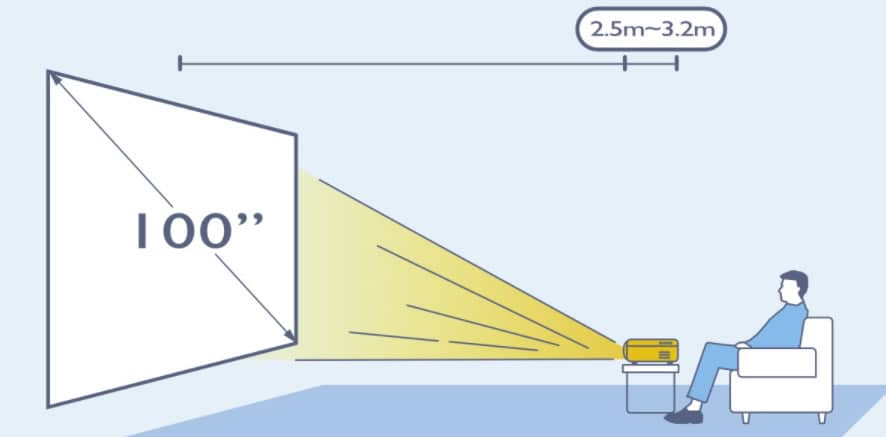
- Projection balance less than 1: It is a short focal length. That means we can put the projector very close to the screen.
- It included in 1 and 2: A projection balance of 1.5 will take a setback of 3 meters when it is 2 meters wide.
- Greater than 2: It is a long lens. The projector will usually be behind the person looking at it.
Choosing the right balance of projection will help avoid problems during installation. You can find out more about different arrangements with our calculators.
HD ready resolution: Screen distance = Screen width x 1.8
Full HD resolution: Screen distance = Screen width x 1.5
4K resolution: Screen distance = Screen width ‘screen x 1
Image Corrections / Adjustments
Projectors can have a really big screen. They can also do other things, like zoom. But they don’t always work if the projector and the screen are not lined up.

- Zoom: A projector allows you to change the size of the screen. It can be low or high amplitude.
- Lens Shift: This is an optical correction. It means that the image is not changed and does not change quality. The projector can move, and it will still be ok.
- Keystone (or trapezoidal correction): This is a digital process that makes images straight. If you put the projector at an angle, the image will be trapezoidal instead of rectangular.
Some models have keystone correction. However, it is not the case with lens shifts too much.
Connections
In the full configuration, your projector must be connected on the one hand to a content source (TV decoder, Blu-Ray player, game console, computer, etc.) and on the other hand to audio equipment to have sound at the height of the image (for home cinema use).
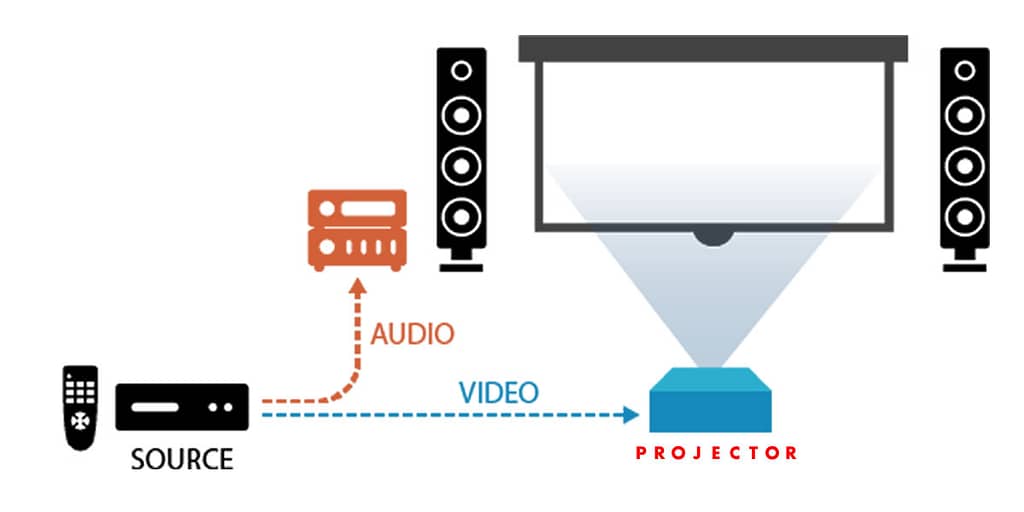
The connection between the source and the projector can be wired or wireless:
- Wired connection: for home cinema use, HDMI is the standard for HD, whatever the resolution.
- Wireless connection: for office use, Wi-Fi compatible projectors exist. It is recommended for superior quality to use the Wireless modules offered by the manufacturers, which are unfortunately relatively expensive (> 200 USD).
- Mobile/tablet connection: there are several standards (MHL, Miracast) to view your photos and videos, with or without cable, directly from your phone.
The connection between the source and the audio equipment (hi-fi system, soundbar, amplifier, etc.) will depend on your equipment.
- RCA (the classic red and white connector, found on all devices) for stereo sound
- Coaxial, optical, or HDMI for 5.1 sound
- Bluetooth if compatible
More information on the connection
TIPS: HDMI or DisplayPort connectors are considered to have the best picture quality
Sound
Standard projector lamps get very hot and need to be cooled by fans. You can hear the fans, but the sound of the movie usually drowns them out.
If you want a quiet projector, look for those with a low sound level. You can find it on the decibel level, and it is usually 25-35 dB. If you have an eco mode, this will also reduce the noise.
A short focal length can help a lot. You should put the projector closer to the screen than to people. They will not notice the noise from it as much.
Tips: Choose less than 30 dB for your projector
Screen
Fixed or mobile, the projector screen is an essential element of a home cinema installation. There are different kinds and formats (for cinema or games use you need a 16: 9 projection screen).
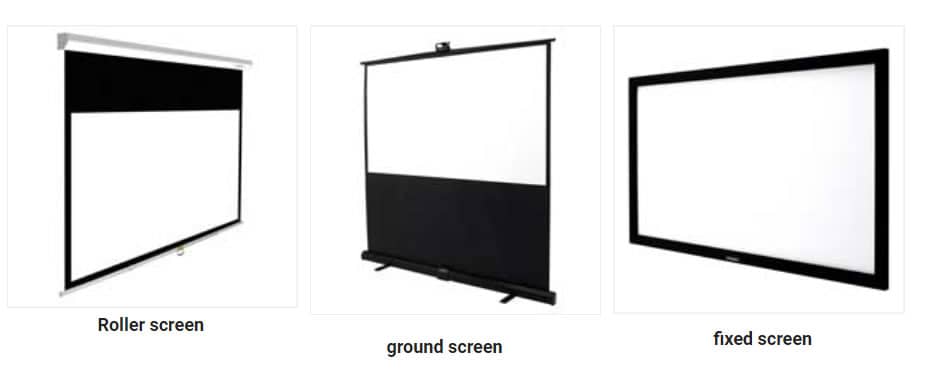
- Roll-up projector screen: can fix it to the wall or the ceiling. The canvas is unrolled (manually or automatically) on demand.
- The screen on the ground (pull-up): the principle is the same, but the screen support is just placed on the ground, and the canvas unrolls upwards. No fixing required.
- The projector screen on a tripod: you can use it for mobile or office use.
- Fixed screen: the best solution because the canvas remains stretched and does not deform. In return, the projector screen is always visible (ideal if you have a dedicated home cinema room).
You can also use a white or gray wall but with a very uneven result depending on the surface type.
See the projector screen buying guide
Which screen size to choose from?
The optimal screen width will depend on your preferences and the distance you have. If the choice of the ideal size remains very subjective, there are purely indicative “recommendations” (issued in particular by SMPTE and THX) that can help you choose.
Support
Although they can use the most projector by being placed on a table or piece of furniture (for occasional use in particular), they are often fixed to the wall or ceiling, especially in “home cinema” configurations.
You will find support available for all budgets: ceiling or wall, telescopic, motorized, etc.
Price
The projector offers, from less than $ 300 to more than $ 5,000, and one of the first selection criteria, will usually be the budget you have.
For a quality home cinema projector, the models with the best value for money are between 500 and 1000 USD. To facilitate your choice, we have selected the most efficient projectors of the moment (by price range), in particular, according to tests and user reviews.
If you are looking for a cheap projector, you can go for an unbranded model (or an “alternative” brand). However, be careful with an actual performance which is below that of projectors from major brands like BenQ, Optoma, Epson, or Sony for example.
Maintenance
When purchasing your projector, you can take into record the costs of buying a replacement lamp. Depending on the lamp, the price can vary from 40 to 450 USD.
Usually, the life of a lamp is between 2000 and 4000 hours. When it comes to mobile projectors, lamp life is much shorter, from 1000 to 1500 hours, due to the different constructions.
If you want to use the projector daily while minimizing maintenance costs, Hybrid Laser-LED projector is more interesting. It cannot change the latter’s lamp, but its life can be up to 20,000 hours. In addition to the costs of purchasing the lamp, the costs for replacing the lamp, if you are not allowed to do it yourself (for example, if you are a school).
The costs for a replacement lamp can vary between 40 and 450 USD. LED spotlights have lamps with a longer lifespan.
Conclusion:
When it comes to buying a projector, there are many things you should consider before making your final decision. The type of room the projector will be in and how far away from the screen you’ll be sitting in can affect what kind of technology is best for you.
For instance, DLP Projectors would work well if you have a large space that’s dark enough or a smaller space with lots of lights on.
3LCD (or tri-LCD) projectors may not provide high-quality pictures but they do offer better color reproduction and contrast than their other counterparts such as LCOS projection systems which produce more natural colors without glass light filters and are often used in digital cinema production environments due to its excellent black levels.
Statistics Of The Projector Buying Guide
- If the contrast of your screen is too high, then some people can’t see it as well. To fix this problem, you can change the brightness on your phone to 50%.
- 3D movies are much brighter than normal.
- However, if a projector advertises that it covers a specific RGB color gamut range like DCI-P3 or Rec. 709 then beware because most 3D films are shot in BT. The same goes for screens/projection surfaces that require special projection equipment to adequately bright display the projected light from a projector.
- A good projector can show your color. It might be 95% of what you see.
- Some projectors cover over 100% of the screen. The Samsung LSP9T projector is a good example.”
- For the best color on a projector, choose one that has the most coverage of BT.2020, which is the newest color standard created by ITU-R. This new standard applies to televisions, home theater projectors, digital cinema projection systems and more.
- If you want the best possible picture quality, you’ll likely spend between $6K and $25K.
- It is 100% worth getting a video projector if you want to have the cinema in your living room.
- A DLP projector has a zoom setting of 1.2x, which means the projected image will be larger than normal.
- The lens shift is a correction method that keeps the resolution of an image. It’s better than keystone distortion because it does not distort the image like keystone distortion does.
Frequency ask question
How do I choose a projector?
Choosing a projector depends heavily on what you plan to use it for. A projector’s resolution, brightness, and contrast ratio all play a role in how good your video will look.
When you’re thinking about how to choose a projector, it’s essential to first think about where you’ll be using the projector. Most people use it in their living room, classroom or office.
You’ll need to consider the size of the room and how well the projector will work in that space. Currently, the best projectors use LED light sources. They’re highly energy-efficient, so they don’t use as much power as older projectors did. They also last longer, and they’re brighter.
How many lumens do I need for a projector?
To determine the number of lumens required, you must evaluate the size of your display area and the distance you will sit from it.
How to calculate the distance?
The shortest distance from your seats to your screen is called “throw” and it’s measured in meters. To know how many lumens you need, divide the number of feet between projector and screen by 12 (feet). Example: If you are projecting onto a 100-inch display 20 feet away from your seat then that would work out as an equivalent 16 foot throw or 1200 total lumens needed.
What else do I need to consider when buying a projector for my classroom?
Lumens aren’t everything! The brightness doesn’t matter much if the student can’t see what they’re doing on their desk because there isn’t enough light in the room. Projectors come with different features
Is 7000 lumens good for a projector?
The brightness of the projector’s image is measured in lumens. A projector’s brightness is measured in ANSI lumens. The ANSI lumens specification is the most commonly used measurement of illumination for a projector.
What projector should I buy for home?
Necessary features for projectors for home use include:
- Native resolution: HD 1080p
- 4K Ultra HD is a perfect choice for home theater rooms.
- Full HD (1920×1080) resolution.
- 2,000 lumens or brighter.
- A contrast ratio of 5000: 1 or better.
- Color support: 1.06 billion (8-bit) or more.
- HDMI input – for home entertainment systems.
Are cheap projectors any good?
Low price projectors are typically not any good. They are usually low quality and have many issues. Even cheap projectors can be found that are excellent, but be wary of inexpensive models. While quality control often lacks affordable projectors, you can find some for as low as $100 that will work for your needs.
What is better for a projector, DLP, or LCD?
DLP projectors offer great value with their high contrast ratios and stunning colors. LCD projectors provide a wider viewing angle. If you are looking for a small projector and have the money for it, you should go with the DLP projector. If you are looking for a giant projector and are willing to spend a little more, you should go with the LCD projector.
What should I look for when buying a projector?
When purchasing a projector, you should consider the brightness, contrast ratio, resolution, and connectivity ports.
Brightness: The brightness of the projector will determine how well it can display an image in a dark room. Consider this when purchasing your next projector because you don’t want to purchase something that is too dim or has poor contrast for watching movies in the dark. Look for projectors with light output between 2000 and 5000 lumens. A large percentage of projectors on the market today offer 2000-3000 lumens, but there are some that boast 6000+ (although these cost more).
Contrast Ratio:The higher the number here, typically, the better quality images it produces–contrast ratios above 1000:1000 tend to produce good results if you’re planning on using your new projector mainly inside without much ambient light interference from windows
Is it worth buying a 4K projector?
4K or Ultra HD is the next step beyond Full HD. 4K is about four times as sharp as Full HD. 4K TVs and projectors have a resolution of 3840×2160 pixels.
It depends on how big the screen you will be projecting on is. The 4K resolution is not necessary if you will be projecting on a smaller screen.
Is projector better than TV for eyes?
The short answer is “yes.” Projector screens are usually easier on your eyes than TV screens. Projectors are more beneficial than regular TVs due to their ability to create images over 100″ and the fact that they can display smaller objects.
What about 3D home theater projectors?
3D home theater projectors make it easier than ever to enjoy the ultimate in 3D movie entertainment. 3D technology uses two images and two projectors to create a realistic 3D image on the screen that appears to jump off the screen and into your lap.
Before you shop for a projector, you should consider the size of the screen, the brightness of the image, and the type of connection the device offers.
Why do screen size and throw distance matter?
What should match a projector’s screen size and throw distance to the size of its audience to reach the largest group of viewers?
What is the throw ratio?
Throw ratio, the distance from the center of an image on a screen to the projector divided by the distance between viewer and screen, can help you determine what type of projector you need.
The ratio determines the size of the image projected and how far from it you need to be. If you want a nice big photo, then you want a low throw ratio.













